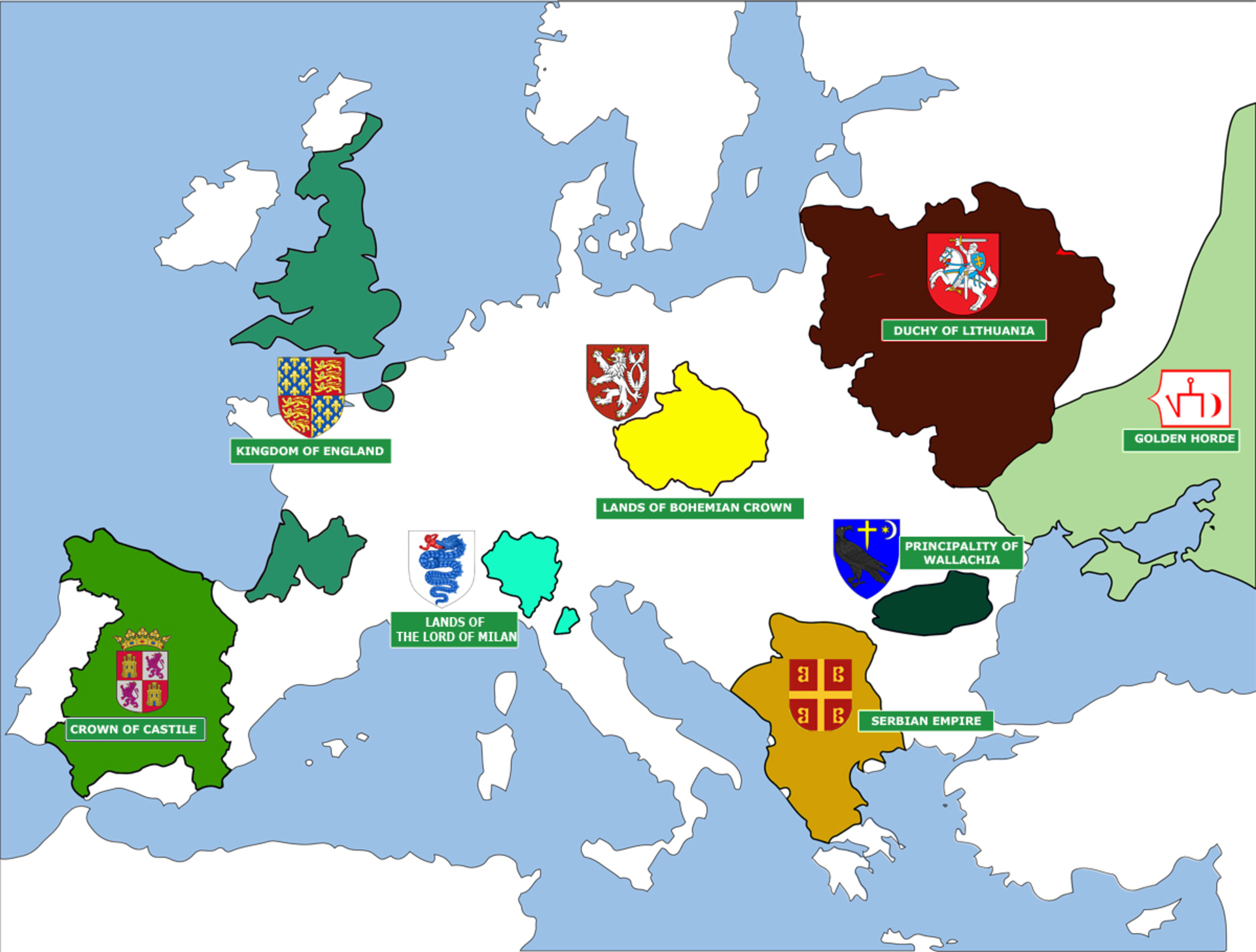The European Championship 1350
In mid-14th century Europe was devastated by the plague. The Christian forces occupy almost the entire Pyrenees Peninsula. England and France started The Hundred Years’ War. The Byzantine power faded. Mighty Czech king became an emperor of Holy Roman Empire. The Tatars ruled over the East Europe. The Pope found himself in "exile", etc.
In mid-14th century Europe was devastated by the plague. The “exile” in Avignon, and the later double election during the 14th century, undermined the authority of the popes. The Tatar rulers ensured the supremacy the Prince of Moscow over other principalities. The Muslim state in the Pyrenean Peninsula was reduced to Granada and its surrounding area. The Serbian ruler Dušancame to rule a great part of the Balkans, and the power of Byzantine emperors found itself in a state of constant decline. The Bohemian king Charles of Luxembourg became the Emperor of the Holy Roman Empire, and Prague became one of the most important cultural and intellectual centers of Europe. Louis Anjou sat the Hungarian throne (1342-1382), and his ambitions lead him to wars from Naples and Sicily, to the Tatar Golden Horde on the Black Sea. England and France found themselves in the first decades of endless wars over the rights on particular duchies in the Kingdom of France, and later over the right on the French crown. Medieval reality was such that there were no “foreign” ruling families, because the world of those times did not recognize any“national” criterion in the choice of a ruler. Most countries at the beginning of the 14th century had unstable borders. Various political entities (kingdoms, duchies, principalities) were organized on the dynastic principle, and were gained through wars, familial or marital contracts, and as such they often changed their borders.In general, the nobility in the feudal society was prepared to accept any ruler who would guarantee their former, or bestow new privileges upon them. The criteria for turning people for or against a ruler were in most part religious and economic factors, not national ones. The nobility did not see itself as a part of the underprivileged common population. The lower classes could not imagine the “shape” of Hungary, France, the Holy Roman Empire, etc. Maps were a rarity even among the elites, and they were not even remotely precise.
At the beginning of the 14th century only Milan, Venice, and Paris had over one hundred thousand citizens. Only with the material progress between the 11th and 13th century did economic circumstances change their direction and mark the beginning of thenew life for the cities which had barely existed before that, and those that did exist served only as religious centers, or were used for defense. The medieval city shares its characteristics with the countryside. There are vineyards within city walls, gardens as well, there are even pastures or fields; cattle are kept there, and muck and droppings are collected. Nevertheless, in the medieval society there is a stark dividing line between those living in a city and those living in the countryside. The population of the cities engaged in crafts and mercantile activities, and the latter were the class that disturbed the order of things in the feudal system, because they represented a powerful economic class that does not subordinate itself to the clerical or military class. Therefore, the common opinion among clerics about cities is that they are a “gathering place of shameless traders and craftsmen.” The medieval Church deemed that lending money with interest is a sin for Christians, and those who engaged in such activities were excommunicated. Seen as how Jews were not a part of the feudal system, nor did the canon law pertain to them, they were allowed to partake in money-lending and profiting from it, so some of them became financial experts over time. Their wealth became the reason why they were often targets of attacks, even though the hatred towards the Jews constituted an integral part of European Christian culture. Over centuries the Jews started to be perceived as monstrous characters straight from the imagination that were used as scapegoats for social anxieties and personal fears of individuals.

Sources
- Georges BENSOUSSAN, Europska strast za genocidom : povijest genocidnih ideja i djela, Zagreb, 2010.
- Fernard BRAUDEL, Civilizacije kroz povijest, Zagreb, 1990.
- Marc BLOCH, Feudalno društvo, Zagreb, 2001.
- Esad ĆIMIĆ, Drama ateizacije. Religija, ateizam i odgoj,, Sarajevo, 1971.
- Niall FERGUSON, Uspon novca : financijska povijest svijeta, Zagreb, 2014.
- Grupa autora,''Gradovi i trgovina'': Velika ilustrirana enciklopedija, Zagreb, 2009.
- Grupa autora, Povijest: Razvijeni srednji vijek , knjiga VII., Zagreb 2008.
- Jacques LE GOFF, Civilizacija srednjovjekovnog Zapada, Zagreb 1998.
- Marko PIJOVIĆ, ''Demistificiranje ''etniciteta'' '', Historijska traganja, 10/2012.
- MARIJANOVIĆ, '' stoljeća progona na putu prema holokaustu. Otkuda dolazi mržnja prema Židovima? Osvrt na mračnu stranu europe povijesne nepravde i nove opasnosti po židovski narod'', http://www.advance.hr/vijesti/stoljeca-progona-na-putu-prema-holokaustu-otkuda-dolazi-mrznja-prema-zidovima-osvrt-na-mracnu-stranu-europe-povijesne-nepravde-i-nove-opasnosti-po-zidovski-narod/
- Ivan HRSTIĆ, ''Svi hrvatski mitovi i zablude, od stoljeća sedmog'', http://www.politikaplus.com/novost/54776/svi-hrvatski-mitovi-i-zablude-od-stoljeca-sedmog
Sources for map
- https://www.pinterest.com/pin/53550683047973700
- https://www.alternatehistory.com/forum/threads/need-a-map-of-europe-the-world-in-the-mid-1300s.69862/
- http://one-europe.net/eurographics/political-map-of-europe-in-1346
- http://www.zum.de/whkmla/histatlas/russia/haxgoldenhorde.html
- https://en.wikipedia.org/wiki/Serbian_Empire
- https://royalcello.websitetoolbox.com/post/italy-as-wed-wish-it-to-be-6959613
- https://commons.wikimedia.org/wiki/Atlas_of_Ukraine
- http://althistory.wikia.com/wiki/Europe_1430,_1430-1460_(Map_Game)
Izvor za fotografiju: https://pixabay.com/en/dance-of-death-danse-macabre-dance-155250/
